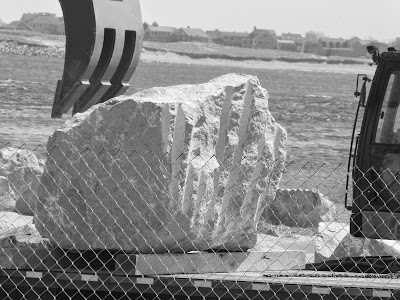The stone being used for the jetty is high strength granite. The Army Corp has tested the stone to verify it can withstand the intense battering that sea throws at the Salisbury jetty during a rough storm. Many of the large granite blocks have visible drill holes. The drill holes are 4 inches in diameter and are closely spaced together in a line. They extend to the bottom of the granite block. Once all the holes are drilled, the walls between the holes are broken away mechanically or vaporized with a thermal torch. This separates the side of the granite block from bedrock. In the early 1900s this method was known as broach channeling but I not sure what the modern term is for it.
Granite block with drill marks on a flatbed awaiting removal.
8.36 ton granite block. A line of "half round" drill marks across the top.
Close-up of a series of closely spaced drilled holes.
4 inch diameter drill hole. A quarter for size reference.
Granite blocks stored on the beach.
Note: These photos were taken when access to the beach section of the construction site was still possible. It has since been fully fence off for safety reasons.





No comments:
Post a Comment